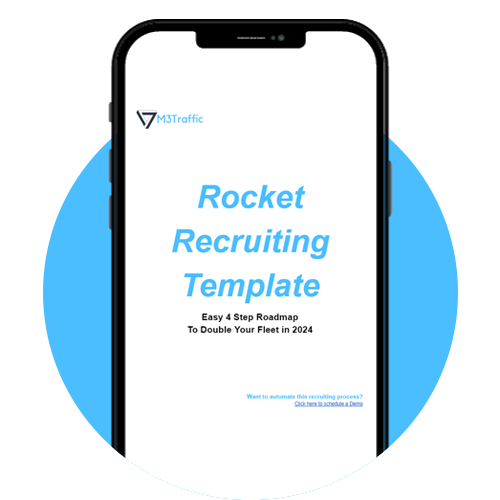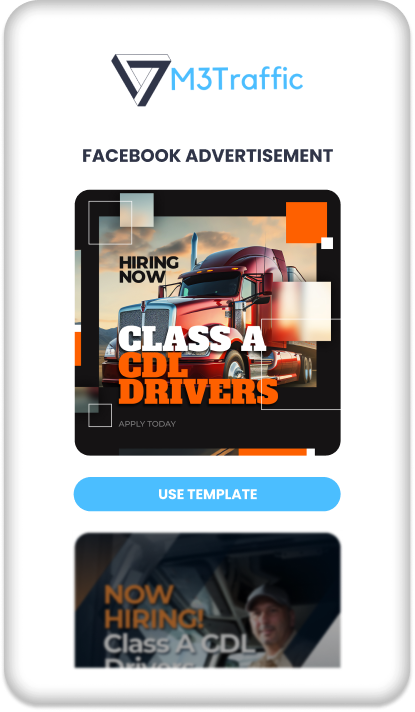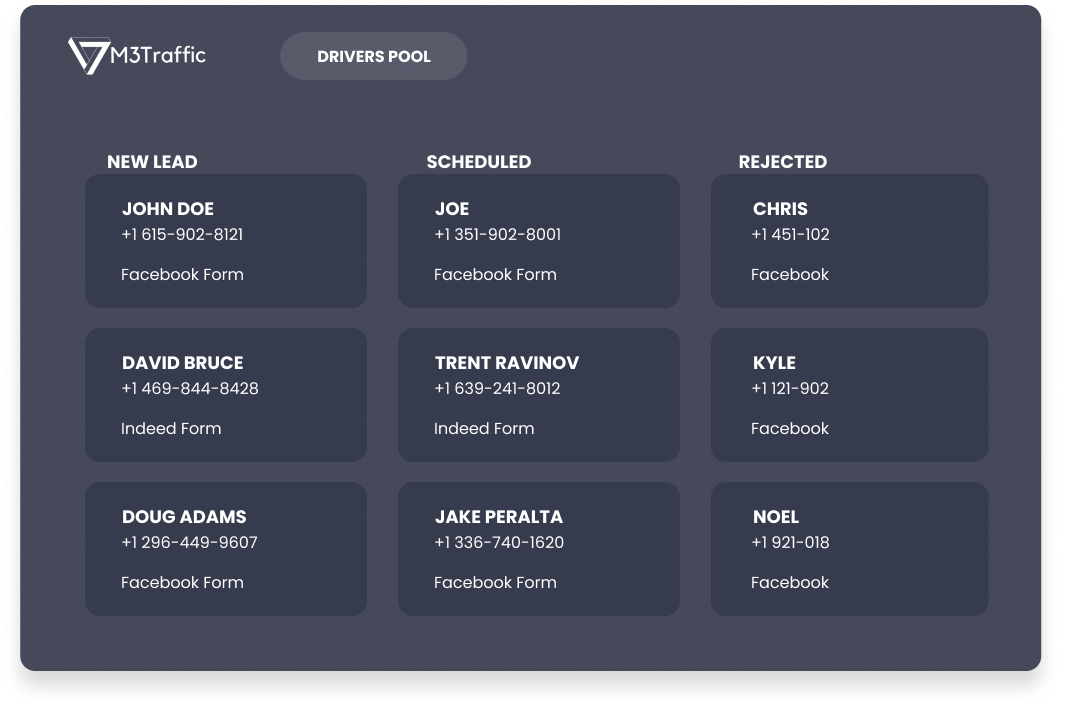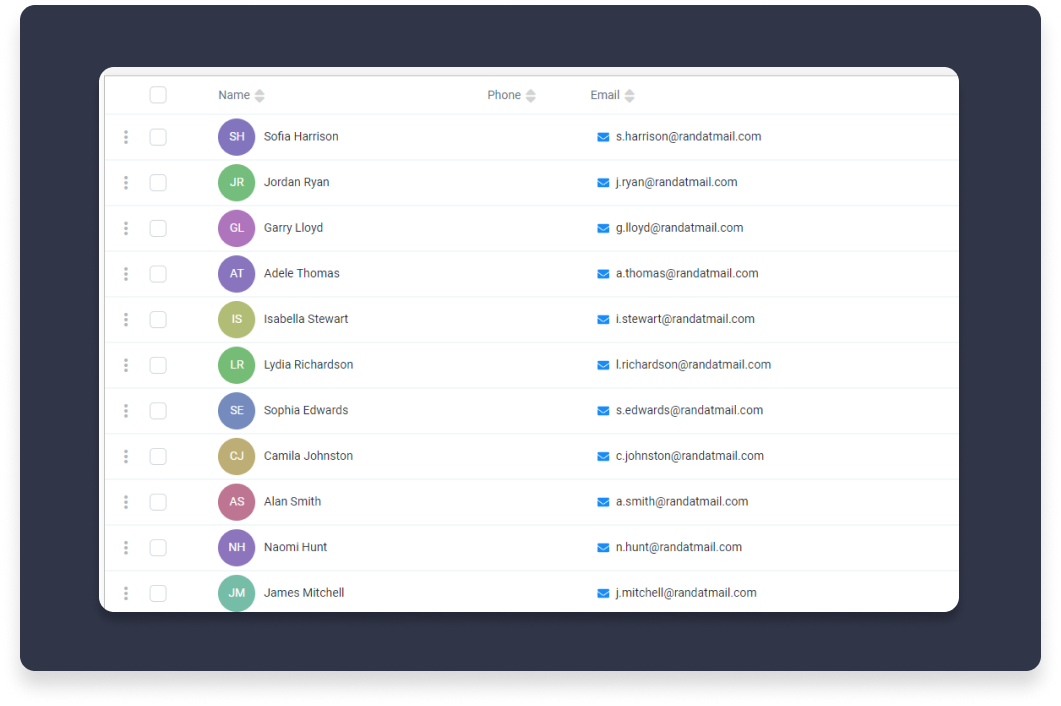Helping Companies Hire The Best Drivers FAST... Guaranteed!
Take control of your perfect recruiting process to consistently grow your fleet without relying on crowded job boards or expensive recruitment agencies.
Helping Companies Hire The Best Drivers FAST... Guaranteed!
Take control of your perfect recruiting process to consistently grow your fleet without relying on crowded job boards or expensive recruitment agencies.

Download Our Rocket Recruiting Template
Easy 4 Step Roadmap To Double Your Fleet in 2025

Download Our Rocket Recruiting Template
Easy 4 Step Roadmap To
Double Your Fleet in 2024
Customers Who Use Us
Customers Who Use Us

Access The Entire
Driver Pool
No more relying only on the job boards. Easily access all the drivers in your market by launching ads in minutes that have been proven to work and generate over 80,000 leads.
"It's been just 1 week and we already have 4 interviewed drivers with confirmed interest including a lead driver with 7 others pending in the Savannah area."
Logan P.

Save Time and Focus On Qualified Candidates
Reduce wasted time on unqualified candidates by filtering them out and instantly engage with your qualified candidates. The largest processor of driver applications did a study to find that you are 30% more likely to hire a driver if you respond within 5 minutes. Qualified applicants will show up on your calendar asking you to call them and give them an interview.
“With your system, it does it for us, making our job a little easier. We couldn’t keep up with all the candidates we have without your follow up system. Most of our tenured drivers are because of your follow up system."
Jasmynn F.

Lower Your Cost Per Hire by Building Your Waitlist
As the saying goes, fortune is in the followup.
By building your own company database of drivers and storing it in your system, you have permission to message them at will free of charge because you own this database. Next time you need to fill a position, use your own database rather than relying on someone else’s advertising platform or a crowded job board.
“Robert had a list of 300 drivers built up in his waiting list. Using ALIS, he sent out a message to them and had 25 interviews scheduled almost instantly for free and filled his position in 2 days. "
Access The Entire
Driver Pool
No more relying only on the job boards. Easily access all the drivers in your market by launching ads in minutes that have been proven to work and generate over 80,000 leads.
"It's been just 1 week and we already have 4 interviewed drivers with confirmed interest including a lead driver with 7 others pending in the Savannah area."
Logan P.


Save Time and Focus On Qualified Candidates
Reduce wasted time on unqualified candidates by filtering them out and instantly engage with your qualified candidates. The largest processor of driver applications did a study to find that you are 30% more likely to hire a driver if you respond within 5 minutes. Qualified applicants will show up on your calendar asking you to call them and give them an interview.
“With your system, it does it for us, making our job a little easier. We couldn’t keep up with all the candidates we have without your follow up system. Most of our tenured drivers are because of your follow up system."
Jasmynn F.
Lower Your Cost Per Hire by Building Your Waitlist
As the saying goes, fortune is in the followup.
By building your own company database of drivers and storing it in your system, you have permission to message them at will free of charge because you own this database. Next time you need to fill a position, use your own database rather than relying on someone else’s advertising platform or a crowded job board.
“Robert had a list of 300 drivers built up in his waiting list. Using ALIS, he sent out a message to them and had 25 interviews scheduled almost instantly for free and filled his position in 2 days. "

Join the One Driver Away Challenge Today!
Ready to hire your next great driver? Take the challenge for only $99 – Pay once, and get lifetime access to the proven system that will help you recruit drivers quickly and efficiently. No more guesswork, no more wasted time.
Frequently Asked Questions
Is advertising spend included?
No, the budget that you’d like to allocate to any advertising platform will be separate. The budget you will spend to hire a driver will vary widely depending on a number of factors. For you to estimate, we usually see lead costs ranging from $3 - $20 per lead using adlaunch pro.
Can you manage the advertising for me?
Yes, we do have an option to manage the advertising budget for you and maximize the number of leads you get. This is an option if you have an ad budget exceeding $3,000 per month. Schedule a demo and we can discuss exactly how that works and see if you are a good candidate for that.
I already use Tenstreet, driver reach, or another ATS. Can I use this?
Congratulations on having a system that you use. We have various options of integrating with driver reach and tenstreet or other platforms depending on your need. Schedule a demo and we can walk through the best option for that.
Is there a long-term contract?
No long term contracts. We operate on a basis where we make sure that you are happy. If it’s not working for you, you are able to cancel with a written 30 day notice.
Latest Blog Posts

5 Reasons It Takes 45 Days to Fill Driver Positions
5 Reasons It Takes 45 Days to Fill Driver Positions
(And How to Cut It in Half)
Forty-five days. That's how long it takes the average trucking company to fill a driver position. Forty-five days of empty trucks, lost revenue, and watching competitors snap up the drivers you can't seem to reach.
If that sounds acceptable to you, then you're probably okay with losing $18,450 in potential revenue per empty seat while you struggle to find someone – anyone – who will actually answer your calls.
Here's the brutal reality: while you're spending six weeks trying to fill one position, your competitors with better systems are filling theirs in 18-25 days. They're not just faster – they're capturing the drivers you never even get to talk to. And the longer your hiring process drags on, the more likely those drivers are to accept offers from companies that actually know how to reach them.
The 45-day hiring cycle isn't just inefficient – it's a competitive death sentence in today's market. Every day you can't fill a position is another day your competitors are building stronger teams, serving more customers, and growing their operations while you're stuck playing phone tag with drivers who may not even be interested.
The Real Cost of Slow Hiring
Let's talk about what 45 days actually costs you, because most companies dramatically underestimate the true impact of slow hiring. It's not just about the empty truck – it's about the cascading effects throughout your entire operation.
Direct Revenue Loss ($18,450 per position) Every day a truck sits empty, you're losing approximately $410 in potential revenue. Multiply that by 45 days, and you're looking at $18,450 in lost revenue per position. For a company that replaces 20 drivers per year, that's $369,000 in revenue that simply evaporates while you struggle to fill positions.
Operational Stress and Overtime Costs When you're short-staffed for 45 days, existing drivers work longer hours to cover the gap. This leads to increased overtime costs, driver fatigue, and higher turnover among your current team. You're essentially paying premium wages to cover for positions you can't fill, while simultaneously burning out the drivers you already have.
Customer Service Impact Forty-five days of being short-staffed means delayed deliveries, missed commitments, and frustrated customers. Some of those customers will find alternative carriers during your staffing crisis. The revenue impact extends far beyond the immediate lost loads – you're potentially losing long-term customer relationships.
Competitive Disadvantage While you're spending 45 days trying to fill one position, competitors with 20-day hiring cycles are filling two positions and expanding their capacity. They're not just more efficient – they're actively capturing market share while you're stuck in hiring limbo.
Why It Takes So Long: The Root Causes
The 45-day hiring cycle isn't random – it's the predictable result of broken processes that most companies accept as "normal." Understanding why it takes so long is the first step to fixing it.
The Contact Problem Here's the dirty secret most companies won't admit: they feel like they have no one good to talk to. Your recruiters spend most of their time trying to reach drivers who don't answer their phones. When you finally do get someone on the line, they're often not qualified, not interested, or not available when you need them.
The fundamental problem is that manual recruitment processes can't solve the contact challenge. Your recruiters are calling during business hours when drivers are working. They're using generic approaches that feel like spam calls. They're competing with dozens of other companies using the exact same broken strategies.
The Phone Tag Nightmare Even when drivers are interested, the back-and-forth of scheduling interviews and follow-up calls adds weeks to the process. Your recruiter calls, leaves a voicemail, waits for a callback that may never come. The driver calls back when your recruiter is busy with someone else. This phone tag can go on for weeks, and many potential hires give up and take other jobs while you're still trying to schedule a conversation.
The Desperation Cycle As the 45-day mark approaches, desperation sets in. You start lowering standards, skipping important vetting steps, and rushing through the hiring process with whoever you can actually reach. This often leads to poor hiring decisions that result in quick turnover, starting the 45-day cycle all over again.
Inconsistent Follow-up Manual processes rely on human memory and organization. Recruiters get busy, forget to follow up, or lose track of where they left off with each candidate. Meanwhile, drivers who might have been interested move on to companies with more organized, responsive processes.
The Automation Solution
Here's where smart companies are gaining massive advantages. Instead of accepting 45-day hiring cycles as inevitable, they're using automation to eliminate the fundamental bottlenecks that cause delays.
Automated systems solve the contact problem by reaching drivers when and how they prefer to be contacted. Instead of random phone calls during work hours, they send initial text messages that explain who's calling and why. They schedule callbacks for times when drivers are actually available to talk. They eliminate the phone tag that adds weeks to the hiring process.
Most importantly, automation ensures consistent, professional follow-up without human error. Every candidate gets timely responses, clear communication, and a smooth experience that reflects well on your company. This isn't just about efficiency – it's about creating a hiring process that actually attracts quality drivers instead of frustrating them.
The results speak for themselves. Companies using automated recruitment systems typically reduce their time-to-hire from 45 days to 18-25 days. That's not just an improvement – it's a transformation that affects every aspect of their operation.
The Competitive Reality
While some companies are still accepting 45-day hiring cycles, others are using technology to gain significant competitive advantages. They're not just filling positions faster – they're capturing the best drivers before competitors even know they're available.
These companies can afford to be more selective because they're not constantly in crisis mode. They can build relationships with drivers instead of just trying to fill immediate openings. They can provide better candidate experiences because they're not rushing through conversations with the few people who happened to answer their calls.
The gap between companies that solve the hiring speed problem and those that don't is widening every month. Fast-hiring companies are building stronger teams, serving more customers, and growing their operations while slow-hiring companies are stuck in perpetual staffing crises.
The Hidden Productivity Drain
Beyond the obvious costs, 45-day hiring cycles create hidden productivity drains throughout your organization. When hiring takes forever, it becomes a constant crisis that consumes management attention and resources. Instead of focusing on growth and improvement, you're always in firefighting mode.
Your existing drivers see the constant staffing struggles and start questioning whether your company has its act together. Some of them start looking for opportunities with more stable, better-organized companies. The hiring crisis becomes a retention crisis, making the problem even worse.
Meanwhile, your competitors with faster hiring processes can focus on strategic initiatives, customer service improvements, and business development while you're stuck trying to fill basic staffing needs.
The Technology Solution
The technology to dramatically reduce hiring timelines exists today. Automated systems can handle initial outreach, schedule appointments when drivers are available, and ensure consistent follow-up without human error. They can personalize communications at scale and adapt to individual driver preferences.
But the real value isn't just in the speed – it's in the quality of hires. When you can fill positions in 20 days instead of 45, you're not desperate. When you're not desperate, you can be selective. When you're selective, you hire drivers who stay longer and perform better.
Companies that implement these solutions don't just hire faster – they hire better. They build stronger teams, provide better service, and grow faster than competitors who are still stuck with 45-day hiring cycles.
Latest Blog Posts

5 Reasons It Takes 45 Days to Fill Driver Positions
5 Reasons It Takes 45 Days to Fill Driver Positions
(And How to Cut It in Half)
Forty-five days. That's how long it takes the average trucking company to fill a driver position. Forty-five days of empty trucks, lost revenue, and watching competitors snap up the drivers you can't seem to reach.
If that sounds acceptable to you, then you're probably okay with losing $18,450 in potential revenue per empty seat while you struggle to find someone – anyone – who will actually answer your calls.
Here's the brutal reality: while you're spending six weeks trying to fill one position, your competitors with better systems are filling theirs in 18-25 days. They're not just faster – they're capturing the drivers you never even get to talk to. And the longer your hiring process drags on, the more likely those drivers are to accept offers from companies that actually know how to reach them.
The 45-day hiring cycle isn't just inefficient – it's a competitive death sentence in today's market. Every day you can't fill a position is another day your competitors are building stronger teams, serving more customers, and growing their operations while you're stuck playing phone tag with drivers who may not even be interested.
The Real Cost of Slow Hiring
Let's talk about what 45 days actually costs you, because most companies dramatically underestimate the true impact of slow hiring. It's not just about the empty truck – it's about the cascading effects throughout your entire operation.
Direct Revenue Loss ($18,450 per position) Every day a truck sits empty, you're losing approximately $410 in potential revenue. Multiply that by 45 days, and you're looking at $18,450 in lost revenue per position. For a company that replaces 20 drivers per year, that's $369,000 in revenue that simply evaporates while you struggle to fill positions.
Operational Stress and Overtime Costs When you're short-staffed for 45 days, existing drivers work longer hours to cover the gap. This leads to increased overtime costs, driver fatigue, and higher turnover among your current team. You're essentially paying premium wages to cover for positions you can't fill, while simultaneously burning out the drivers you already have.
Customer Service Impact Forty-five days of being short-staffed means delayed deliveries, missed commitments, and frustrated customers. Some of those customers will find alternative carriers during your staffing crisis. The revenue impact extends far beyond the immediate lost loads – you're potentially losing long-term customer relationships.
Competitive Disadvantage While you're spending 45 days trying to fill one position, competitors with 20-day hiring cycles are filling two positions and expanding their capacity. They're not just more efficient – they're actively capturing market share while you're stuck in hiring limbo.
Why It Takes So Long: The Root Causes
The 45-day hiring cycle isn't random – it's the predictable result of broken processes that most companies accept as "normal." Understanding why it takes so long is the first step to fixing it.
The Contact Problem Here's the dirty secret most companies won't admit: they feel like they have no one good to talk to. Your recruiters spend most of their time trying to reach drivers who don't answer their phones. When you finally do get someone on the line, they're often not qualified, not interested, or not available when you need them.
The fundamental problem is that manual recruitment processes can't solve the contact challenge. Your recruiters are calling during business hours when drivers are working. They're using generic approaches that feel like spam calls. They're competing with dozens of other companies using the exact same broken strategies.
The Phone Tag Nightmare Even when drivers are interested, the back-and-forth of scheduling interviews and follow-up calls adds weeks to the process. Your recruiter calls, leaves a voicemail, waits for a callback that may never come. The driver calls back when your recruiter is busy with someone else. This phone tag can go on for weeks, and many potential hires give up and take other jobs while you're still trying to schedule a conversation.
The Desperation Cycle As the 45-day mark approaches, desperation sets in. You start lowering standards, skipping important vetting steps, and rushing through the hiring process with whoever you can actually reach. This often leads to poor hiring decisions that result in quick turnover, starting the 45-day cycle all over again.
Inconsistent Follow-up Manual processes rely on human memory and organization. Recruiters get busy, forget to follow up, or lose track of where they left off with each candidate. Meanwhile, drivers who might have been interested move on to companies with more organized, responsive processes.
The Automation Solution
Here's where smart companies are gaining massive advantages. Instead of accepting 45-day hiring cycles as inevitable, they're using automation to eliminate the fundamental bottlenecks that cause delays.
Automated systems solve the contact problem by reaching drivers when and how they prefer to be contacted. Instead of random phone calls during work hours, they send initial text messages that explain who's calling and why. They schedule callbacks for times when drivers are actually available to talk. They eliminate the phone tag that adds weeks to the hiring process.
Most importantly, automation ensures consistent, professional follow-up without human error. Every candidate gets timely responses, clear communication, and a smooth experience that reflects well on your company. This isn't just about efficiency – it's about creating a hiring process that actually attracts quality drivers instead of frustrating them.
The results speak for themselves. Companies using automated recruitment systems typically reduce their time-to-hire from 45 days to 18-25 days. That's not just an improvement – it's a transformation that affects every aspect of their operation.
The Competitive Reality
While some companies are still accepting 45-day hiring cycles, others are using technology to gain significant competitive advantages. They're not just filling positions faster – they're capturing the best drivers before competitors even know they're available.
These companies can afford to be more selective because they're not constantly in crisis mode. They can build relationships with drivers instead of just trying to fill immediate openings. They can provide better candidate experiences because they're not rushing through conversations with the few people who happened to answer their calls.
The gap between companies that solve the hiring speed problem and those that don't is widening every month. Fast-hiring companies are building stronger teams, serving more customers, and growing their operations while slow-hiring companies are stuck in perpetual staffing crises.
The Hidden Productivity Drain
Beyond the obvious costs, 45-day hiring cycles create hidden productivity drains throughout your organization. When hiring takes forever, it becomes a constant crisis that consumes management attention and resources. Instead of focusing on growth and improvement, you're always in firefighting mode.
Your existing drivers see the constant staffing struggles and start questioning whether your company has its act together. Some of them start looking for opportunities with more stable, better-organized companies. The hiring crisis becomes a retention crisis, making the problem even worse.
Meanwhile, your competitors with faster hiring processes can focus on strategic initiatives, customer service improvements, and business development while you're stuck trying to fill basic staffing needs.
The Technology Solution
The technology to dramatically reduce hiring timelines exists today. Automated systems can handle initial outreach, schedule appointments when drivers are available, and ensure consistent follow-up without human error. They can personalize communications at scale and adapt to individual driver preferences.
But the real value isn't just in the speed – it's in the quality of hires. When you can fill positions in 20 days instead of 45, you're not desperate. When you're not desperate, you can be selective. When you're selective, you hire drivers who stay longer and perform better.
Companies that implement these solutions don't just hire faster – they hire better. They build stronger teams, provide better service, and grow faster than competitors who are still stuck with 45-day hiring cycles.

Download Our Rocket Recruiting Template
Easy 4 Step Roadmap To
Double Your Fleet in 2024











